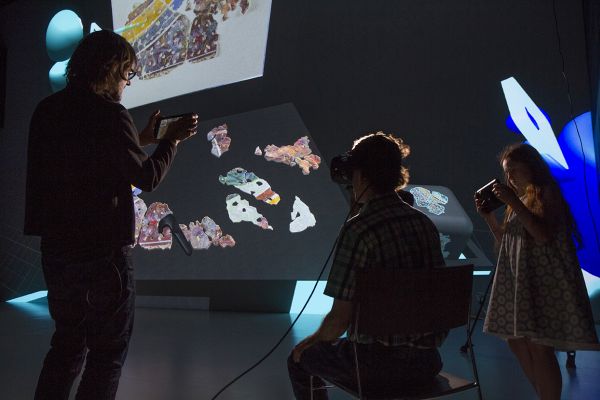Andrea ASCHAUER | Jürgen HAGLER | Jeremiah DIEPHUIS | Michael LANKES
(Playful Interactive Environments – Research Center Hagenberg, Hagenberg, Astria)
Keywords: VR Museum Installation, Virtual Archaeology, Shared VR, Co-located Play
Abstract:
Virtual and Augmented Reality (VR & AR) technologies are becoming increasingly important in educational and cultural contexts, providing users an interactive experience with cultural and historical content. Particularly for material and structures that are no longer in existence or are too fragile to be available to the general public, such approaches permit a level of access that would not be possible otherwise.
However, despite the growing success and promise of VR and AR technologies in this field, current applications primarily focus on an immersive single-user experience and typically do not employ collaborative elements that can promote discussion, reflection and other social aspects. In addition, very little has been done to integrate larger audiences into such activities, which would enable multiple participants and audience members who occupy the same physical space to interact and create a shared cultural experience.
The Virtual House of Medusa (VHM) is an interactive co-located playful VR installation for a museum context that was developed in collaboration with the Federal Monuments Authority Austria to illustrate several fragments of Roman wall paintings. The installation employs a cooperative approach that allows participants to slip into the role of archaeologist and restorer and interact with digitized artefacts. Four virtual workstations provide different perspectives and playful interaction possibilities to actively engage multiple users in their exploration of the remains of an historic Roman villa. The VHM has been undergoing evaluation in multiple museum contexts and preliminary analysis from these activities indicate potential benefits and ongoing challenges for interactive museum installations.
Relevance for the conference: The VHM features an innovative, tested approach to involve multiple participants in an interactive VR museum installation featuring cultural heritage content.
Relevance for the session: The VHM has been exhibited on several occasions (Kunsthistorisches Museum, Ars Electronica Center, et al) and has resulted in a number of lessons learned that are relevant for other museum installations.
Innovation: The VHM effectively deals with the challenge of visualizing overlapping repainted fresco levels from different time periods and actively engaging multiple participants in a museum context.
References:
• Ishii, A., Tsuruta, M., Suzuki, I., Nakamae, N., Minagawa, T., Suzuki, J., Ochiai, Y.: ReverseCAVE: providing reverse perspectives for sharing VR experience. In ACM SIGGRAPH 2017 Posters (SIGGRAPH ’17). ACM, New York, NY, USA, Article 28, 2 pages (2017).
• Sierra, A., de Prado, G., Ruiz Soler, I., Codina, F.: Virtual reality and archaeological reconstruction: be there, back then. MW2017: Museums and the Web 2017. https://mw17.mwconf.org/paper/virtual-reality-and-archaeological-reconstruction-be-there-be-back-then-ullastret3d-and-vr-experience-in-htc-vive-and-immersive-room/, last accessed 2018/02/18.



